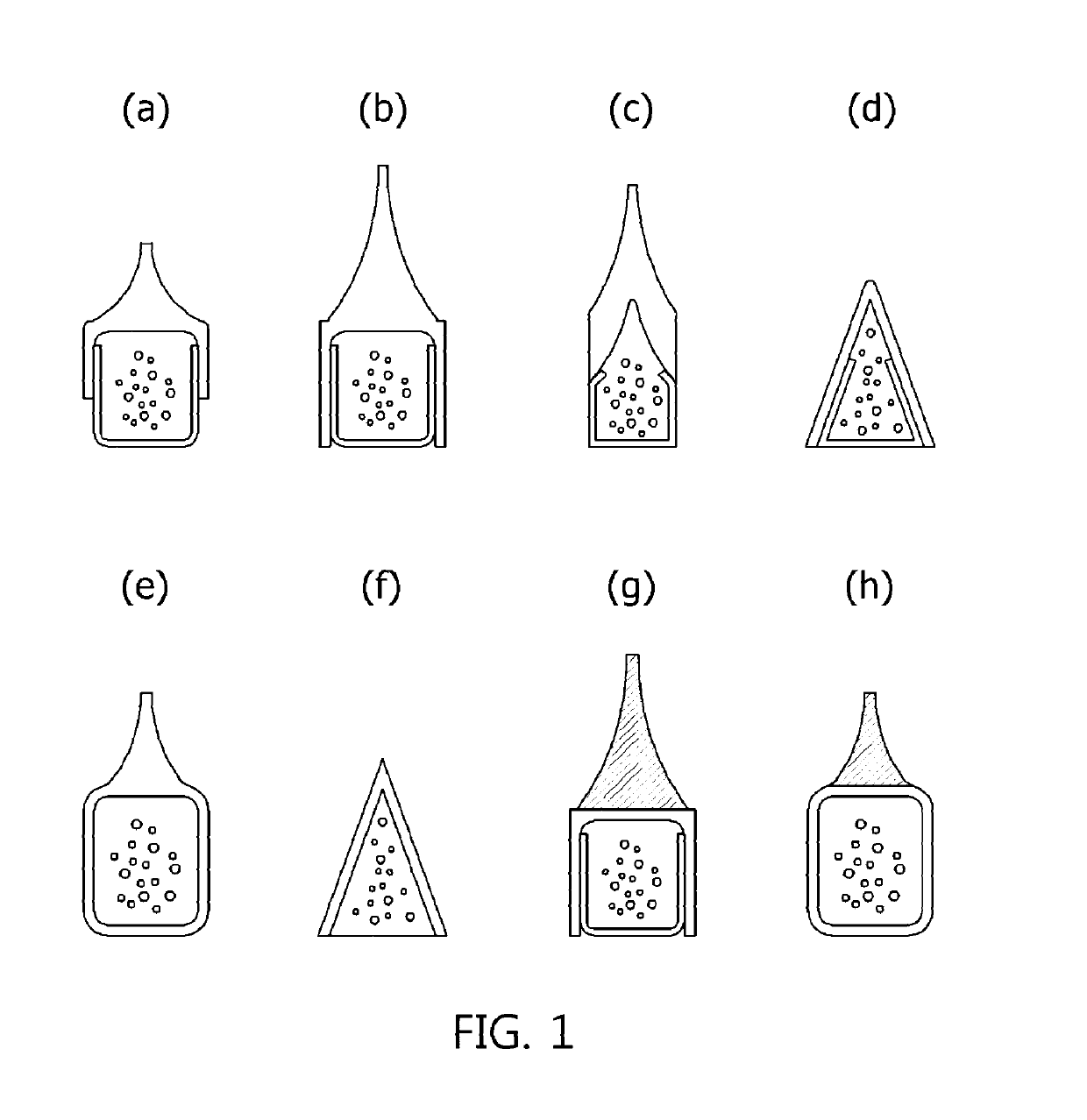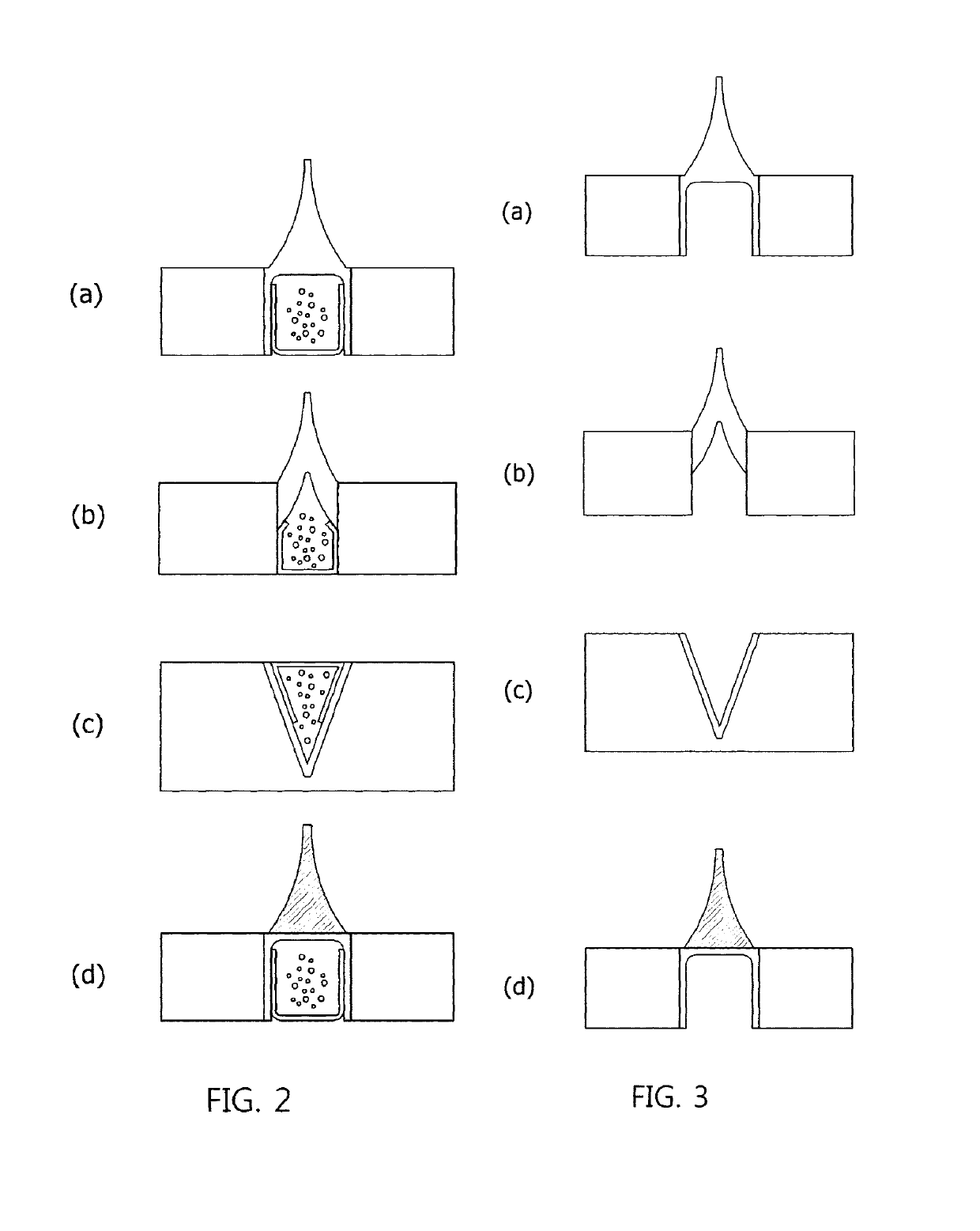Microcellular microstructure and method for manufacturing same
a micro-container and micro-cell technology, applied in the field of micro-container microstructure, can solve the problems of inability to easily use the system, inability to accurately understand the intracellular delivery mechanism through ultrasound technology, and inability to effectively administer drugs in lesions, etc., to achieve efficient loading and easy insertion
- Summary
- Abstract
- Description
- Claims
- Application Information
AI Technical Summary
Benefits of technology
Problems solved by technology
Method used
Image
Examples
example 1
Fabrication of Template for Substrate with Holes Formed Therein
[0128]A template for a substrate with holes formed therein was fabricated using a molding method according to a micro electro mechanical systems (MEMS) process.
[0129]First, to fabricate the template for a substrate with holes formed therein, a circular template formed of steel use stainless (SUS) was fabricated using a laser cutting technology, and pillars having a diameter of 190 μm and a length of 770 μm were formed on a surface of the template (see FIG. 5(a)).
[0130]Subsequently, a polydimethylsiloxane (PDMS) solution was poured into the template and solidified, thereby completing the fabrication of a substrate with holes formed therein (see FIGS. 5(d) and 5(e)). FIG. 5(d) illustrates a cylindrical PDMS substrate with holes formed therein, and FIG. 5(e) illustrates a rectangular pillar-shaped PDMS substrate with holes formed therein.
example 2
Filling Substrate with Holes Formed Therein with Powder-type Sample
[0131]A substrate with cylindrical holes formed therein, formed of solidified PDMS, was coated with a powder-type calcein (fluorescent dye, Sigma-Aldrich) sample, vibrated, and then subjected to a cutting process, thereby completing the process of filling the holes with the sample.
[0132]The powder-type calcein sample was coated on surfaces of the holes, and then the vibrating process was performed using a vortex (Vortex-genie, Scientific Industries), and the cutting process was performed by cutting the surface of the film structure using an edge blade (DORCO).
[0133]FIG. 7(b) illustrates an image of an upper end portion of a substrate with holes formed therein, each of which has a diameter of 375 μm and a length of 843 μm, is completely filled with a powder-type calcein sample, and a cross-sectional image thereof. FIG. 7(c) illustrates an image of an upper end portion of a substrate with holes formed therein, each of ...
example 3
Molding of Microcontainer Film Structure in Substrate with Holes Formed Therein
[0134](1) A substrate with holes formed therein, each of which had a diameter of 500 μm and a length of 385 μm and a cylindrical shape, and was formed of PDMS, was filled with 10% w / v carboxymethylcellulose (CMC, low viscosity, Sigma-Aldrich) as a polymer composition sample, and then a solvent-removing process was performed twice, thereby molding a microcontainer film structure in the holes. A left-side image of FIG. 8(d) shows an upper end portion of the molding-completed microcontainer film structure, and a right-side image of FIG. 8(d) shows the microcontainer film structure separated from the substrate with holes formed therein. FIG. 8(e) illustrates a rectangular pillar-shaped microcontainer film structure separated from a PDMS mold for a substrate with rectangular pillar-shaped holes formed therein.
[0135](2) A substrate with holes formed therein, each of which had a diameter of 258 μm and a length o...
PUM
| Property | Measurement | Unit |
|---|---|---|
| volume | aaaaa | aaaaa |
| volume | aaaaa | aaaaa |
| volume | aaaaa | aaaaa |
Abstract
Description
Claims
Application Information
 Login to View More
Login to View More - R&D
- Intellectual Property
- Life Sciences
- Materials
- Tech Scout
- Unparalleled Data Quality
- Higher Quality Content
- 60% Fewer Hallucinations
Browse by: Latest US Patents, China's latest patents, Technical Efficacy Thesaurus, Application Domain, Technology Topic, Popular Technical Reports.
© 2025 PatSnap. All rights reserved.Legal|Privacy policy|Modern Slavery Act Transparency Statement|Sitemap|About US| Contact US: help@patsnap.com



